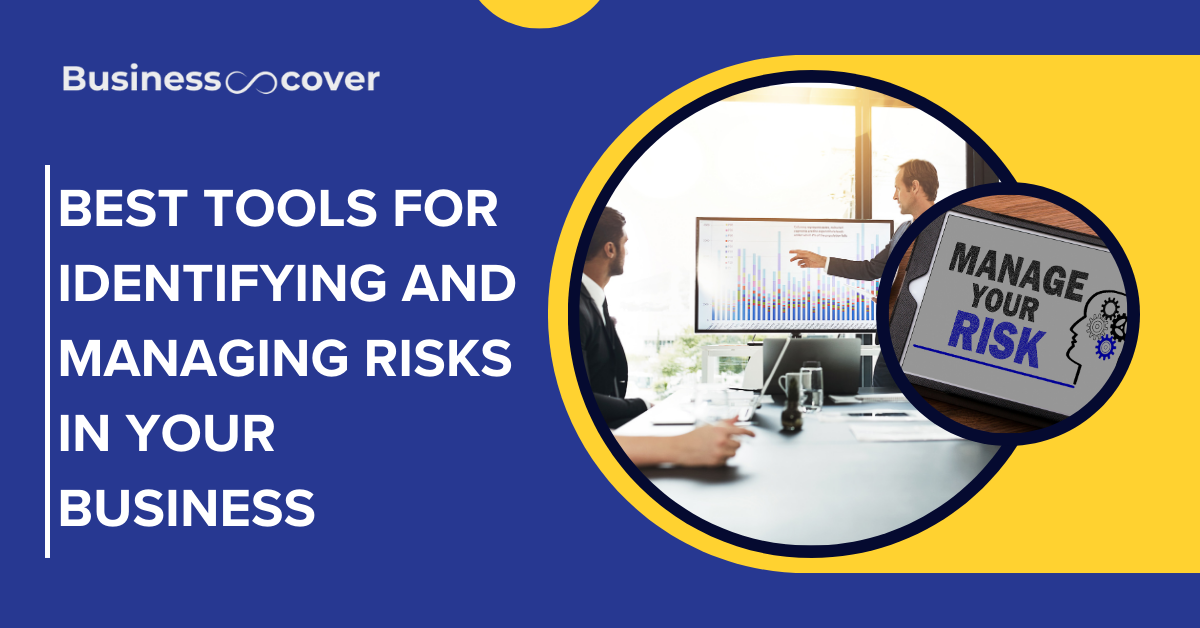As the business world becomes increasingly complex and competitive it is vitally important for organizations and managers to adequately assess and address risks. Organizations operate in an environment full of risks at financial, operational, compliance, and strategic levels. Knowing the risks has a solution and with the right tools can be methodically identified, evaluated and mitigated. Here is a detailed look at some of the best tools ( Risk Management Tools) that you can take advantage of as a business.
1. Risk Management Software

Risk management software is a technology that provides firms with a single location for defining, evaluating, and controlling hazards within different departments. These tools provide a structured approach to risk management, allowing businesses to:
Centralize Risk Data: All risk matters such as documentation and reports should be compiled or grouped in one area where there is access to everyone. This greatly reduces the problem of working in isolation and improves discourse about risk.
Conduct Risk Assessments: Conduct extensive risk assessments of prospective risks that incorporate both forms of investigation: interviewing/surveys, and measurement of risk exposure by statistical analysis and monetary modeling.
Monitor Risks: Monitor the performance of risk management controls in real time and change the risk statuses based on real conditions.
Popular Options
- LogicManager: Celebrated for its stability, LogicManager enables organizations to build risk libraries, perform risk evaluations, and create reports without much difficulty.
- RiskWatch: This software is specifically in the area of security and compliance risk management used in monitoring vulnerabilities in organizations.
- Riskalyze: Specifically used extensively by insurance companies, Riskalyze equips a means of measuring clients’ risk and investment approach.
Case Study: A medium manufacturing organization adopted LogicManager in order to bring all its risks into a single platform. Over the next six months, they enhanced risk exposure visibility, followed by cutting incident response time in half.
2. SWOT Analysis Tools

SWOT is an acronym for Strengths, Weaknesses, Opportunities and Threats; a tool for business to assess internal and external threats. Utilizing SWOT analysis tools enables teams to:
Visualize Factors: Define and illustrate SWOT in a concise and easily segregable manner so that it promotes easy comparisons and analysis. This simplifies complicated relations making it easy to grasp certain relations through such graphical representations.
Prioritize Risks: Define which risks should be managed in the short term based on the effect that they would have on the business, so as to allow teams to prioritise the high-risk/impact areas.
Collaborate: Encourage members of a team to present their ideas to consider all avenues and practices in order to develop a detailed understanding of risks.
Popular Options
- Creately: A set of tools, which can be installed on-web and provide Graphical User Interface for creating an interactive SWOT analysis chart to a wide group of users collaboratively.
- Lucidchart: Offers numerous examples and a clear interface to help with the creation of thorough SWOT assessments.
- MindMeister: Another cool site which would be helpful during brainstorm sessions – it helps you to organize a chaos of risks on the page and divide it into categories.
Example: An example of using MindMeister in business is that a tech startup company conducted SWOT analysis for a new product that it was planning to release. The process assisted them in recognising a threat of competition and align its marketing strategy.
3. Project Management Software

Risk management information systems are used in project management to define the risks linked to certain projects. By using these tools, you can:
Identify Project-Specific Risks: Evaluate risks within specific areas of project time frame, cost control, allocation of resources and interpersonal behaviour among teams, which greatly enhance the prospects of project success.
Track Progress: Check up the efficiency of the measures to minimize risks from the beginning of the project and till its completion, following up the problems that need to be solved.
Facilitate Communication: Share all risks and issues with all stakeholders In other to make sure that everyone is aware of the problem on hand in fighting to solve them.
Popular Options
- Trello: A web-based tool that can be in the form of boards and cards, such that we can easily check a project timeline and possible issues.
- Asana: Provides a framework to create projects, assign tasks and set due dates for task completion, and give an insight of potential risks in project management.
- Microsoft Project: Originally it is a programme planning tool that still encompasses project management and can be used for planning, scheduling and risk evaluation of the project.
Illustration: Asana was employed by a construction company for organizing a massive project. Because weather conditions that may hinder or delay work were identified at the initial stages of planning, there was little or no incidence of delayed planning or scheduling of activities for the respective projects.
Also Read | How Risk Management Tools Can Help You Handle Business Risks
4. Risk Assessment Templates

There exist online templates that will help in the identification and assessment of risks thus making the process easier. Templates provide a structured format for:
Identifying Risks: Identify possible risks that may affect your business or your project implementation and do not leave any risky area unmentionable.
Assessing Impact and Likelihood: Risk assessment should identify each risk and assign the values high, medium or low to the impact and the frequency of the risk occurrence so that the data can be arranged in the risk matrix for better perception.
Developing Mitigation Strategies: List ways and measures to prevent or address the identified risks putting into perspective roles to be played by all parties.
Popular Options
- Smartsheet Templates: Provides possibility to choose the type of templates for risk assessment that may be adjusted depending on the specifics of a business.
- Risk Assessment Matrix Templates: A basic practical Widgit to help identify and plot risks according to their risk and probability.
- Excel Risk Assessment Templates: Offers a versatile approach for corporations which are experienced in using Excel, because it allows immediate feed of data and effective analysis.
Scenario: An example of a risk assessment matrix template was shown in its usage where a healthcare provider applied it in taking an assessment of possibly existing risks in patient safety provisions in that given healthcare provision. Such measures put forward helped avoid new cases of such incidents, training new programmes was initiated.
5. Compliance Management Tools

Regulatory risk management tools assist companies work towards compliance requirements so as not to breach the law. These tools enable organizations to:
Track Compliance Requirements: The software can provide automated alert and notification systems for stakeholder to keep updated with the latest regulations and compliance requirements.
Conduct Audits: The organization needs to conduct review or updates periodically so that it captures the necessary compliance or lack of it necessary for compliance.
Automate Reporting: Create compliance reports in order to show an organization’s commitment to the legal requirements and for interaction with the control institutions.
Popular Options
- ComplyAdvantage: Provides service solutions on compliance risk mitigation particularly in money laundering and terrorism financing.
- GRC Cloud: Delivers a portfolio of governance, risk management and compliance solutions that help manage compliance activities.
- ZenGRC: A tool on which an organisation can register its compliance activities and planned/ongoing audits easily.
Example: A financial services company has implemented ZenGRC to enusre its compliance issues are addressed efficiently. The use of the tool enabled them cut down the amount of time spent on audits by fifty percent while concentrating on the risks.
6. The Business Intelligence (BI) Tools

BI tools give information on operations risks based on analysis of facts and details in graphical forms. These tools help businesses:
Analyze Data: Find patterns that could pave the way to various threats so that they might be resolved before getting worse.
Create Dashboards: This will provide the ability to quickly analyze the organization’s risk profile through KPIs associated with risk management.
Make Informed Decisions: Risk management and allocation of resources should be done strategically by using available data on risks for better result.
Popular Options
- Tableau: A very effective intelligence tool people can use to create and share different dashboards and get deeper analysis of data with the use of it.
- Power BI: Has the strength of providing a good tool for data visualization allowing organizations to transform the raw data into insights.
- QlikView: Offers limited IT support to the user but can help users generate data visualization with limited or no technical support.
Illustration: A retail organization used Power BI to analyze its sales, and patterns in the data showed the organization what risks were looming for inventory. They optimised the supply chain approaches and consequently advanced stock management while scaling down the costs.
Conclusion
Risk management is essential for an organization’s survival and growth. By utilizing effective tools, businesses can manage risks, ensure compliance, and improve decision-making. A tailored risk management plan enhances readiness, while instilling a risk-aware mindset among all stakeholders is crucial. Thus, organizations of all sizes must implement appropriate risk management strategies for safe operations.
People also ask
What may be known as the tool of managing business risk?
The best risk management tools for small businesses include: Risk Assessment Templates: For evaluation of risk so that they can be ranked. Project Management Software: Asana or Trello in this case helps track the progress and also caters for risks. Financial Management Tools: Like QuickBooks used for the management of the financial risks.
What is used in assessing risk?
The four common risk assessment tools are: risk matrix, decision tree analysis, failure modes and effects analysis and bow tie analysis. Other risk assessment methods include what if analysis, failure tree analysis, LOPA (Layer of Protection Analysis) and HAZOP (Hazard and Operability analysis).







